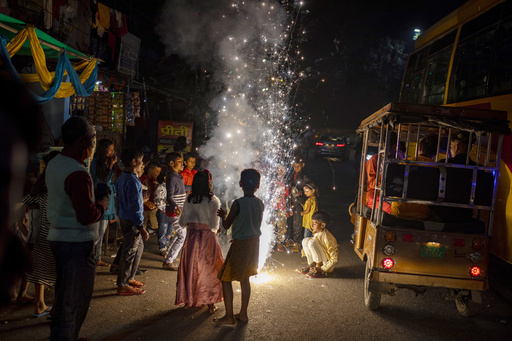
NEW DELHI — With Diwali, the Hindu festival of lights, just around the corner on Thursday, opinions vary among residents about whether to celebrate with firecrackers, which exacerbate India’s ongoing air pollution crisis.
Diwali is typically a time for gathering with family and friends, sharing gifts, and lighting traditional earthen lamps or candles. However, the festivities are frequently clouded by concerns over air quality, as the smoke from firecrackers creates toxic smog that can linger for days.
New Delhi, known for having some of the worst air quality in India, suffers significantly from this issue, often engulfed in a thick layer of smog shortly after Diwali. In 2017, authorities in New Delhi and other regions instituted a ban on the sale and use of firecrackers, encouraging residents to consider alternatives like eco-friendly firecrackers and light shows, though many continue to ignore these rules. Firecrackers remain readily available from vendors on the streets.
Opinions among New Delhi’s residents are mixed regarding the ban’s effectiveness; some feel it’s an essential step towards improving air quality, while others argue it has little impact. Renu, a vegetable vendor who goes by just one name, cherishes the chance to celebrate Diwali, allowing her children to set off firecrackers each year despite concerns.
“Diwali represents a joyful celebration for us, something we have once a year, and I believe the ban should not be enforced,” she expressed.
On the contrary, not all share her view. For instance, 13-year-old Ruhaani Mandal refrains from using firecrackers, admitting they can be fun but recognizing their potential dangers to both people and animals.
“I have witnessed my father struggle with a loss of smell due to pollution, and after Diwali, his health often deteriorates,” she mentioned.
Throughout the months of October to January, New Delhi and other northern cities experience significantly heightened air pollution levels, leading to disruptions in business, school closures, and various health advisories. To combat the haze, officials implement measures such as shutting down construction sites, limiting diesel vehicles, and utilizing water sprayers and anti-smog equipment.
This year, New Delhi has already begun to experience substantial smog, with air quality index readings exceeding 300, a level classified as “very poor.” Various studies indicate that over a million individuals in India succumb to air pollution-related illnesses annually, with tiny particulate matter posing serious risks including chronic respiratory conditions.
Unlike some might believe, firecrackers aren’t the sole contributors to New Delhi’s air quality challenges. Major sources of pollution include vehicle emissions, agricultural burning in neighboring states, and dust from construction activities. Nevertheless, health specialists warn that firecracker smoke can be particularly harmful.
